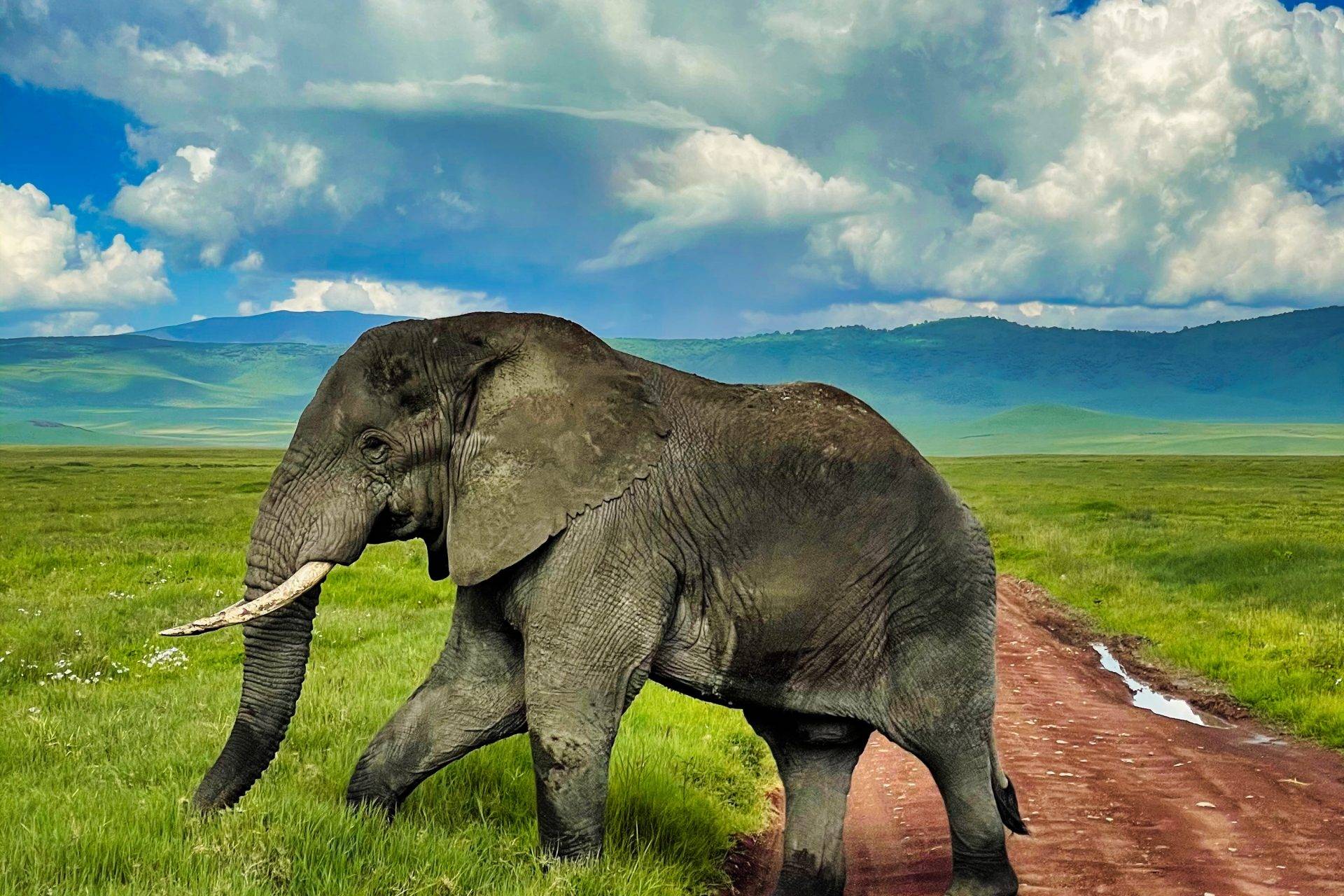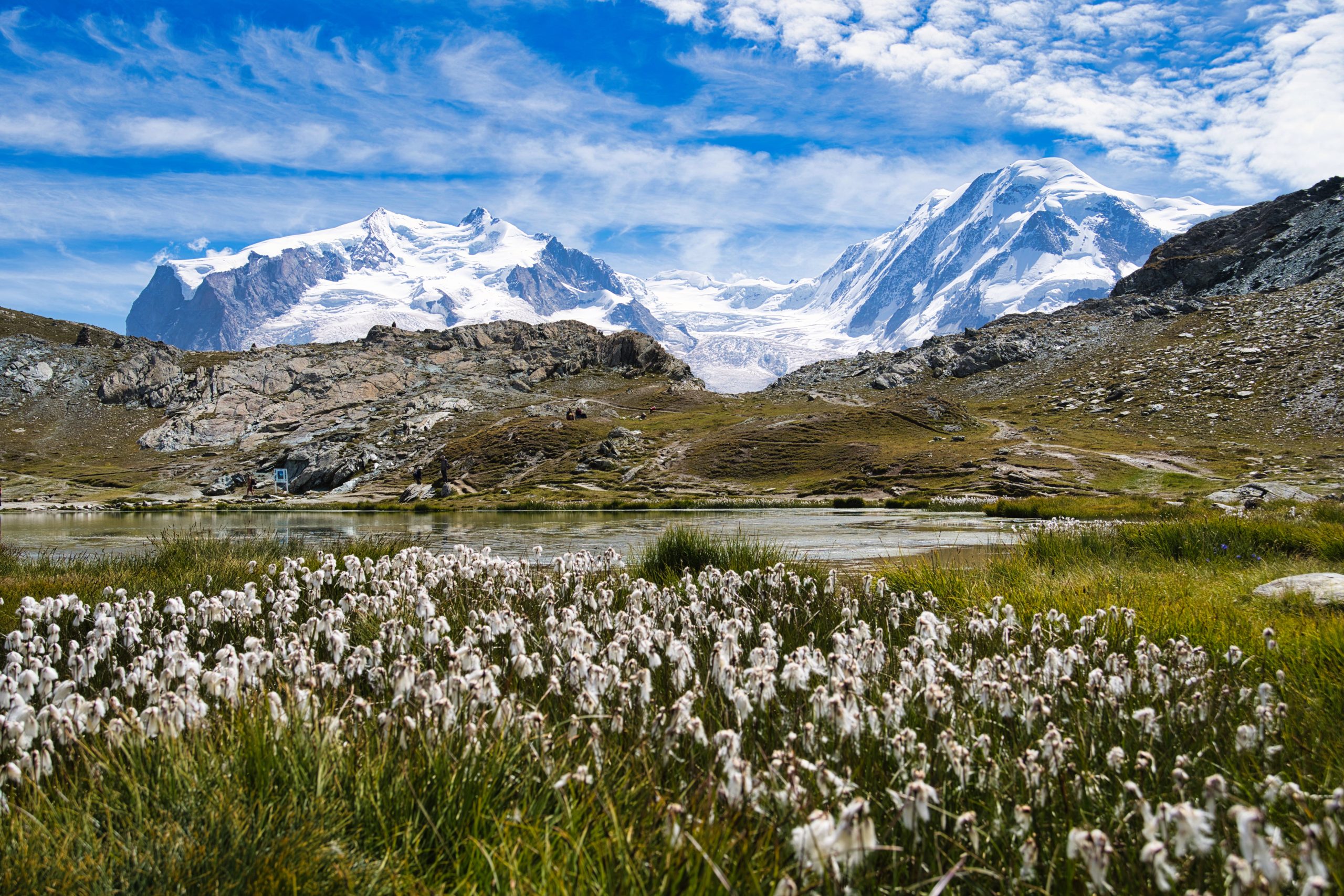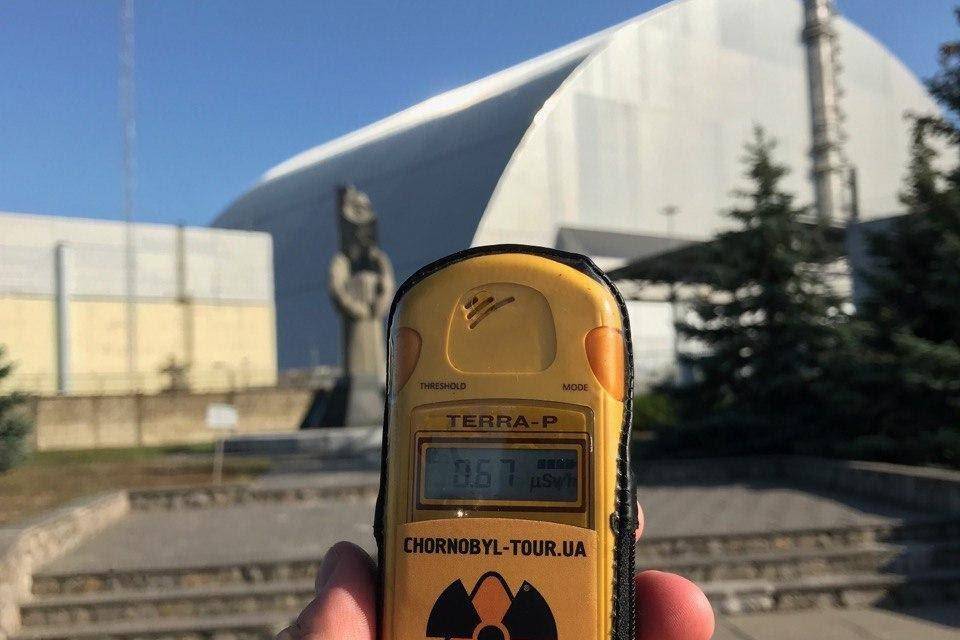Journeying deep into the heart of Mexico’s Yucatán, I found myself walking amidst shadows of a bygone era. The Yucatán Pyramids, silent witnesses to millennia of history, and the ancient coastal city of Tulum beckoned with tales of intrigue, wonder, and a civilization that once was.
Before delving into the detailed tales of each site, let me share some foundational information about the pyramids and Tulum.
An ancient Mayan mystery
The origin of the pyramids and ancient Mayan cities is a topic of great interest and has spurred various theories and speculations over the years.
Here’s a brief overview of some of the versions and arguments that exist:
- Classical Archaeological View: The mainstream archaeological consensus is that the Mayans themselves built the pyramids and cities. This perspective is based on ample archaeological evidence, including tools, inscriptions, and pottery, as well as the continuity of architectural and cultural practices. The Maya had sophisticated knowledge of mathematics, astronomy, and engineering, enabling them to construct their impressive cities and temples.
- «Lost Technology» Theory: Some suggest the Maya had access to certain lost technologies or methods that have not survived to the present day. While this is an intriguing idea, there is little empirical evidence to support it.
- Extraterrestrial Hypothesis: This is a more fringe theory that posits that aliens either assisted or directed the construction of the pyramids and other megalithic structures around the world, including those in the Mayan region. Mainstream archaeologists largely dismiss this theory due to a lack of concrete evidence and because it undermines the achievements of ancient human civilizations.
Atlantean/Lost Civilization Theory: Some believe that remnants of a previous, advanced civilization (often linked to the mythical Atlantis) played a role in the construction of ancient structures worldwide, including those of the Maya. Again, this theory isn’t widely accepted in mainstream archaeological circles because of the absence of direct evidence. - Critics of «How Could They?»: Some people question how the Maya could’ve built such structures without the use of metal tools, wheels, or beasts of burden. However, this underestimates the innovation, knowledge, and capabilities of the Maya. They utilized simple but effective tools made of materials like obsidian and chert, and employed techniques like leverage, manpower, and gradual construction processes to move and place massive stones.
It’s essential to approach these theories with a critical mindset, recognizing that while the Mayan civilization and its accomplishments might seem mysterious, they are not inexplicable. The Maya were a resilient, innovative, and intelligent society with a deep understanding of their environment, which they effectively harnessed to construct their magnificent cities and monuments.
Why the Mayans Built the Pyramids
The ancient Maya built pyramids primarily for religious and ceremonial purposes. These towering structures often served as temples dedicated to various deities and were central to Mayan spiritual practices. Rituals, sacrifices, and other ceremonies often took place at the summit of these pyramids, bringing them closer to the heavens.
Purpose of the Mayan Pyramids:
- Religious and Ceremonial Centers: Pyramids were integral to the religious life of the Maya. The steps leading up to the temple platforms were used for ceremonial processions, and the temples themselves were sites for rituals and sacrifices.
- Astronomical Observatories: Some pyramids, like the one at Chichen Itza known as El Castillo, were built in alignment with celestial events. The play of light and shadow on the pyramid during equinoxes is a testament to the Maya’s advanced astronomical knowledge.
- Burial Sites: Many pyramids served as tombs for nobles and rulers. The burial chambers were often filled with offerings and artifacts to accompany the deceased in the afterlife.
- Discovery in the Yucatán:
Many of the pyramids and ancient Mayan sites in the Yucatán were reclaimed by the jungle after the decline of the Maya civilization. European explorers and later archaeologists rediscovered these sites in the 19th and 20th centuries. John Lloyd Stephens and Frederick Catherwood are among the most renowned figures in this exploration era, documenting and illustrating many sites that had been forgotten.
Tulum, being more accessible due to its coastal location, was known to the Spanish during the early period of colonization. It was not until the late 19th and early 20th centuries, however, that explorers and archaeologists began to study and document Tulum in detail.
Part 1 — Tulum Treasures: My Date with Ancient & Godzilla
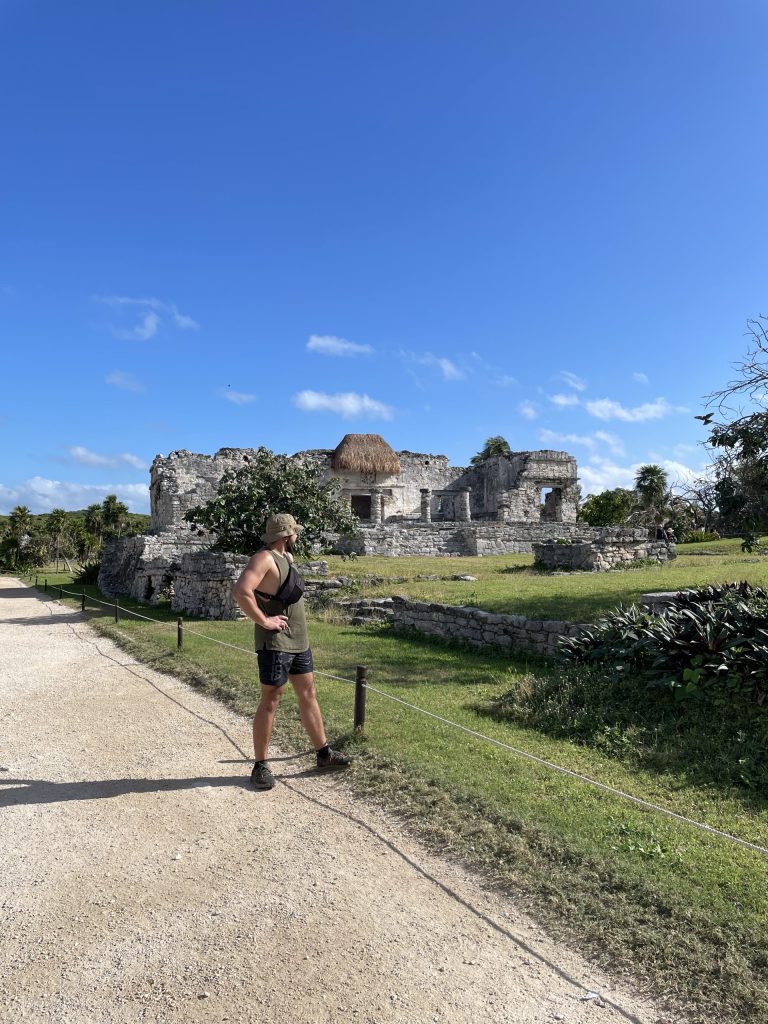 I had read about the ancient Mayan city of Tulum in some articles on the Internet, and of course, I was interested in visiting it. It was the second day of our stay in Yucatan, we had not yet had time to rent a car so we used cab services.
I had read about the ancient Mayan city of Tulum in some articles on the Internet, and of course, I was interested in visiting it. It was the second day of our stay in Yucatan, we had not yet had time to rent a car so we used cab services.
The road from the hotel took about 30 minutes, the driver brought us to the point, and then we walked for about 15 minutes along the picturesque road, fighting off monkeys that periodically came out of the jungle and asked for food.
The road to ancient Tulum passed through modern Tulum. Now Tulum has expensive luxury hotels, bars, discos, crowds of tourists, and beautiful beaches.
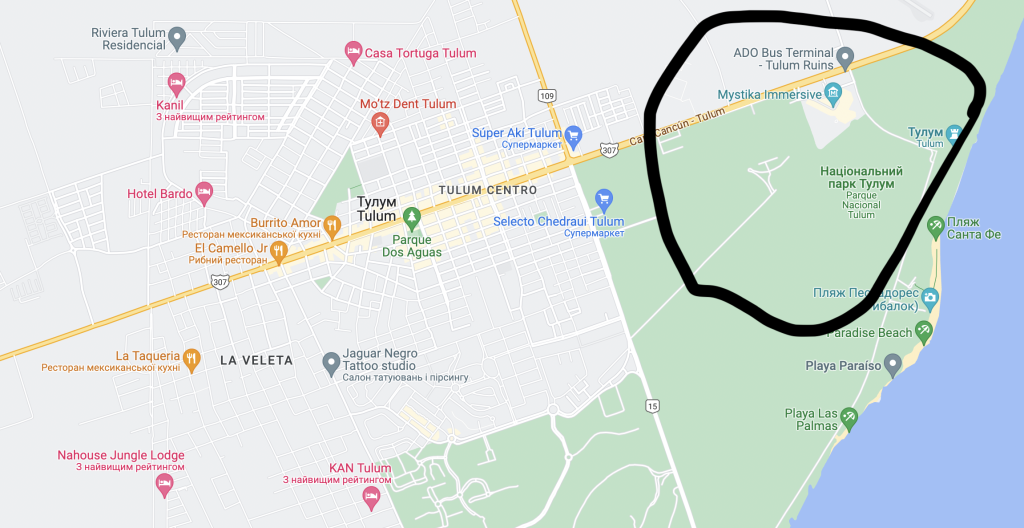
But just ten minutes drive from the noisiest bar are the ruins of an ancient Mayan city
Tulum, perched on the cliffs overlooking the turquoise waters of the Caribbean Sea, was one of the last cities built and inhabited by the Maya. Functioning as a significant port for the city of Coba, Tulum reached its zenith between the 13th and 15th centuries.
Unlike many ancient Mayan cities located deep in the jungle, Tulum was a walled city, its fortifications suggesting a need for defense or a symbol of its status. Given its coastal location, Tulum played a vital role in sea trade, connecting routes from Central Mexico to Honduras.
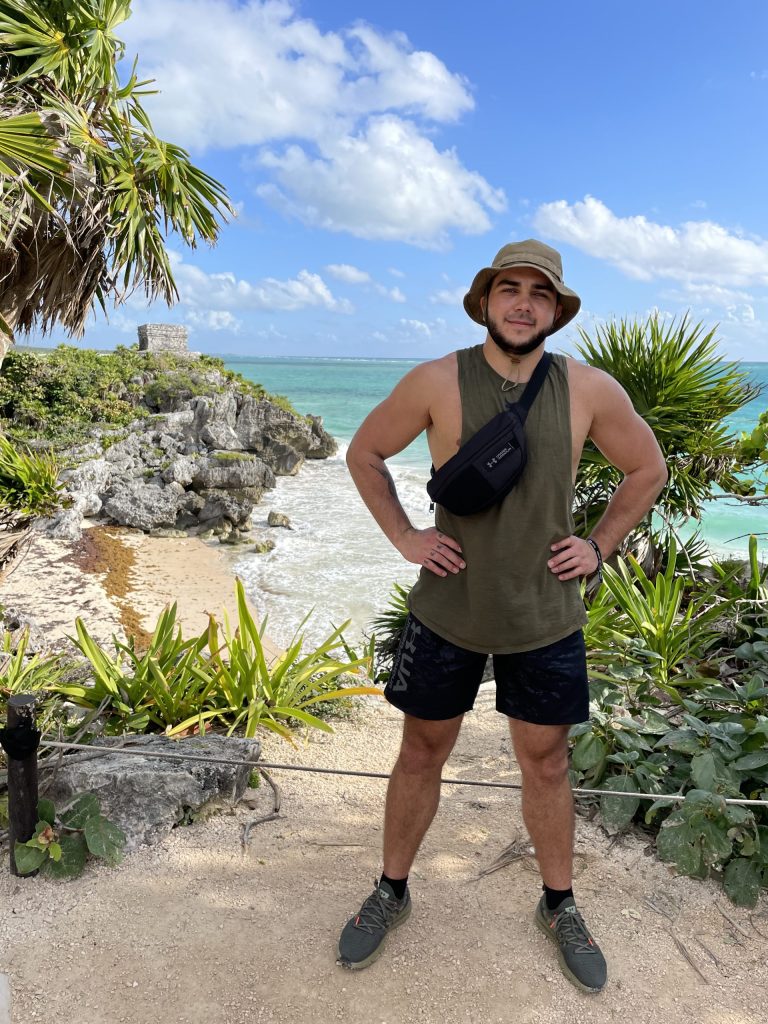
As I wandered through the remnants of Tulum, each step felt like a journey back in time. The still-standing ruins whispered tales of ancient Mayan lives and their remarkable ingenuity. The intricate carvings and enduring structures evoked wonder, considering they were crafted without modern tools. The sea breeze and distant wave crashes only deepened my connection to this once-thriving civilization. Despite the eons that have passed, Tulum stands as a testament to the indomitable human spirit and the fleeting nature of empires. Leaving, I felt a profound appreciation for the Mayans and the enduring legacy of their achievements.
In addition to the people, there were large lizards in the Tulum area, one of them was right on the road, basking in the sun, and I disturbed it just for a photo.
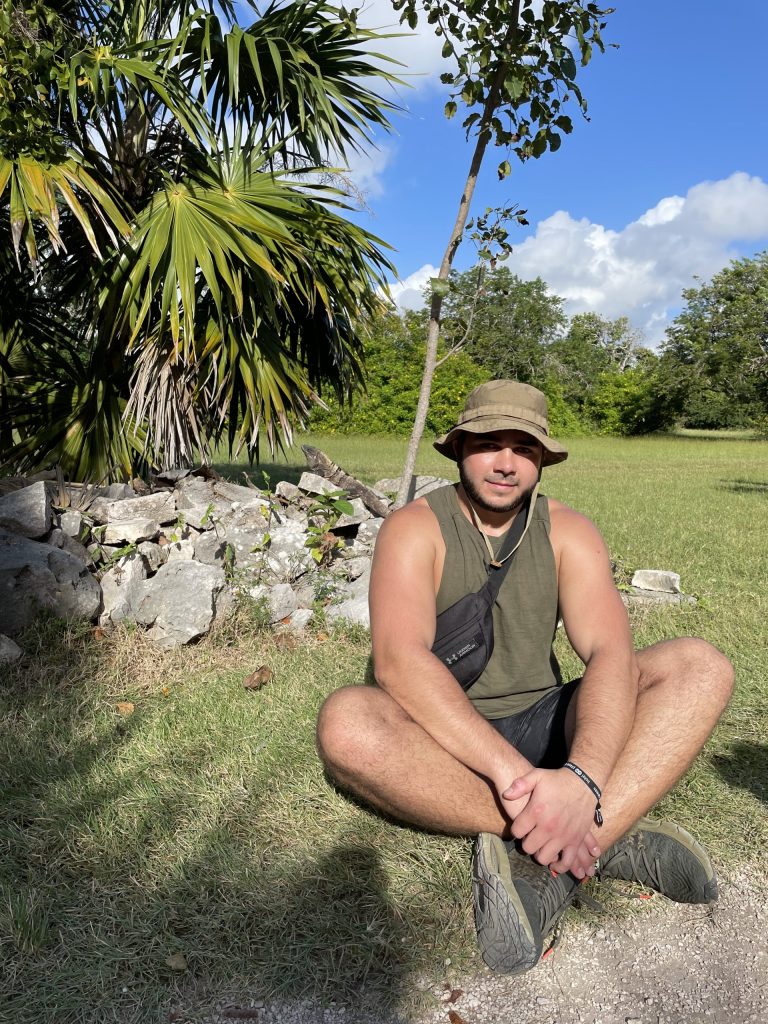
Some tips and advice for visiting Tulum
- Best Time to Visit: The best time to visit Tulum is during the dry season, which runs from November to April. This period offers pleasant temperatures and avoids the peak hurricane season.
- Duration: While you can get a sense of Tulum in a single day, it’s advisable to spend at least 2-3 days to fully explore the ruins and nearby attractions.
- Visit Early: The Tulum ruins can get quite crowded, especially during peak tourist season. It’s best to get there early in the morning, right after it opens, to avoid large crowds and the midday heat.
- Guided Tours: Consider hiring a local guide or joining a guided tour. The history of the Mayans and the significance of each structure is fascinating, and a knowledgeable guide can provide valuable insights.
- Dress Appropriately: Wear comfortable shoes for walking. Consider a hat and sunglasses for sun protection, and always carry water to stay hydrated.
- Nearby Attractions: Apart from the ruins, Tulum is famous for its beautiful beaches. Visit Paradise Beach (Playa Paraíso) located close to the archaeological site. Additionally, there are several cenotes (natural sinkholes) around Tulum, like Gran Cenote and Cenote Calavera, that are perfect for a refreshing swim.
- Stay Local: There are many boutique hotels and eco-resorts in Tulum that offer a unique and intimate experience, contrasting the larger resorts in nearby Cancun.
- Sian Ka’an Biosphere Reserve: Located just south of Tulum, this UNESCO World Heritage site is a vast natural reserve that offers bird watching, kayaking, and the opportunity to see diverse wildlife.
- Eat Local: Tulum offers a variety of dining options. Don’t miss out on trying the local Mexican cuisine. There are many beachfront restaurants, as well as local taquerias in town that offer delicious meals.
Remember to be respectful of the environment and historical sites. Tulum is not just a tourist destination; it’s a place of historical and cultural significance, so leave no trace and enjoy its beauty.
In conclusion, Tulum stands out as one of the best Mayan ruins in the Yucatan, offering visitors a unique blend of historical significance and natural beauty. With its pristine beaches, crystal-clear cenotes, and rich cultural heritage, Tulum is a must-visit destination for those seeking to immerse themselves in the ancient world of the Mayans. Whether you’re an archaeology enthusiast or just someone looking for a picturesque getaway, Tulum promises an unforgettable experience. Its status as one of the best Mayan ruins in the Yucatan is undisputed, making it a top pick for travelers to the region.
Part 2 — Yucatan Pyramids & Mayan Ruins
1. Chichen Itza – Best Yucatan Pyramid
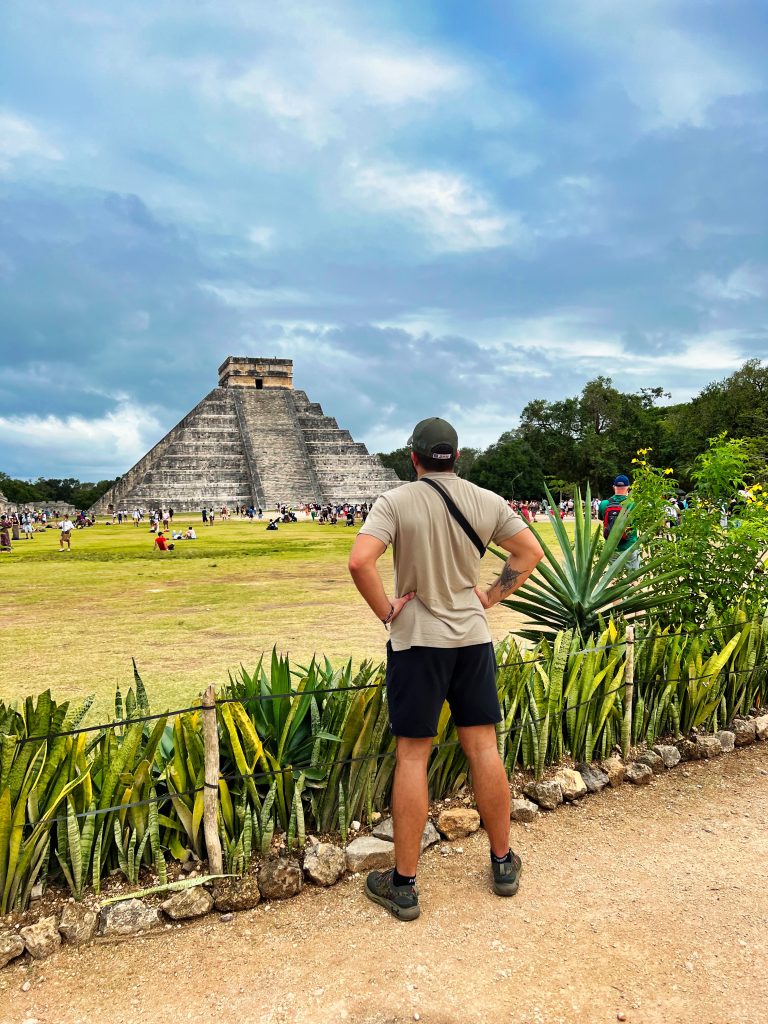
General information
- Height: El Castillo, the main pyramid, stands at approximately 30 meters (98 feet) tall.
- Climbing: As of 2006, climbing El Castillo and accessing its inner chambers is prohibited for preservation and safety reasons.
- Best Time to Visit: The dry season from November to April offers the best weather. To avoid large crowds, especially during the equinox serpent-shadow phenomenon, visit on weekdays and arrive early in the morning.
Chichen Itza, more than just a pyramid, is a symbol of the celestial, terrestrial, and spiritual realms of the ancient Mayan universe. Chichen Itza, recognized as a UNESCO World Heritage Site and one of the New Seven Wonders of the World, remains a testament to the advanced astronomical, architectural, and cultural achievements of the Mayan civilization.
Chichen Itza, which translates to «at the mouth of the well of Itza,» is believed to have been established between the 5th and 6th centuries AD, though it rose to prominence between the 10th and 13th centuries. The site exhibits a fusion of Mayan architectural styles with influences from central Mexico, indicating its importance as a cultural crossroads.
While the entire city of Chichen Itza had various purposes as a major urban center, the pyramid itself, known as El Castillo or the Temple of Kukulcan, served both astronomical and religious functions
- Astronomical: The pyramid is a representation of the Mayan calendar. There are 91 steps on each of the four sides, totaling 364, and including the platform at the top, the total comes to 365, the number of days in a year. Additionally, during the spring and autumn equinoxes, a shadow falls on the pyramid in the shape of a serpent, representing the feathered serpent god, Kukulcan, descending to the earth.
- Religious: El Castillo was dedicated to Kukulcan, a feathered serpent deity, and it likely played a central role in religious ceremonies and rituals. The presence of the sacred cenote, or natural well, nearby, suggests that Chichen Itza was also an important site for rituals related to water and agricultural fertility.
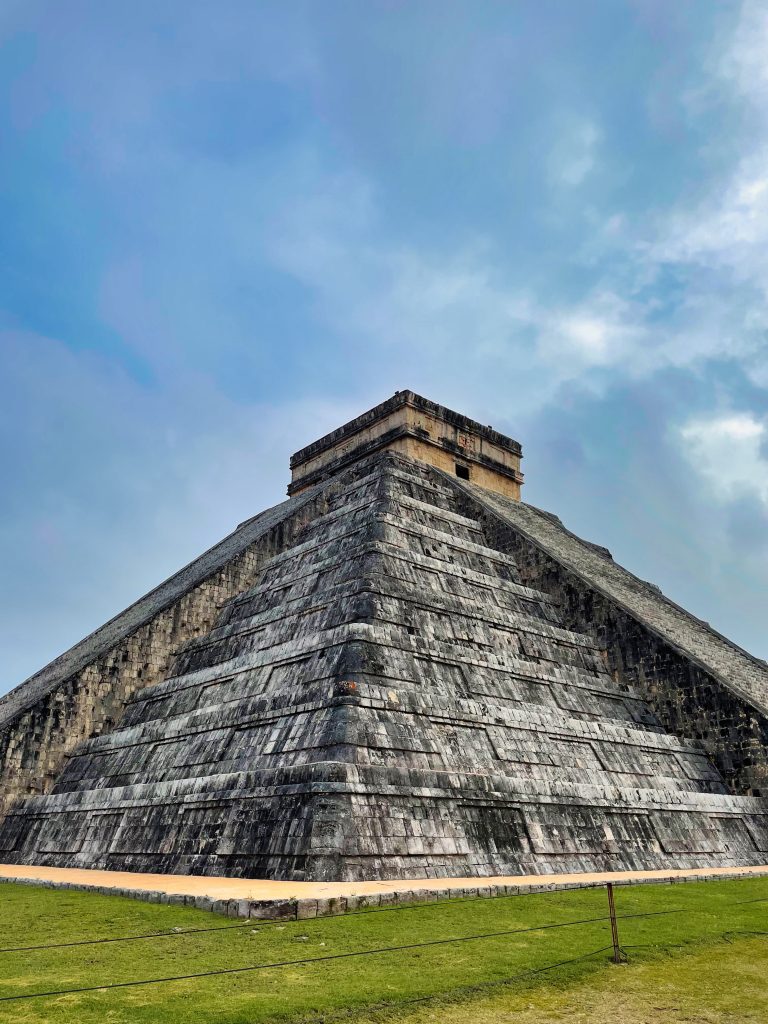 Interesting Facts
Interesting Facts
- Cenote Sagrado: Chichen Itza is home to the Sacred Cenote, a natural sinkhole believed to have been used for sacrificial offerings. Artifacts like gold, jade, and pottery, as well as human remains, have been found in this cenote, reinforcing beliefs about its ceremonial significance.
- Acoustic Phenomenon: If you clap your hands at the base of El Castillo, the echo that comes back sounds like the chirp of the Quetzal bird, a sacred bird in ancient Mayan culture.
- Layers Within: In the 1930s, researchers discovered that El Castillo was built over another, older temple. Inside, they found a Chac Mool statue (a type of ancient Mesoamerican sculpture) and a red jaguar throne studded with jade.
- Great Ball Court: Chichen Itza boasts the largest known ancient Mesoamerican ball court, where ritual games were played. Carvings on the walls suggest that the game had ritualistic significance, possibly including human sacrifice.
2. Uxmal’s Crown Jewel: Pyramid of the Magician
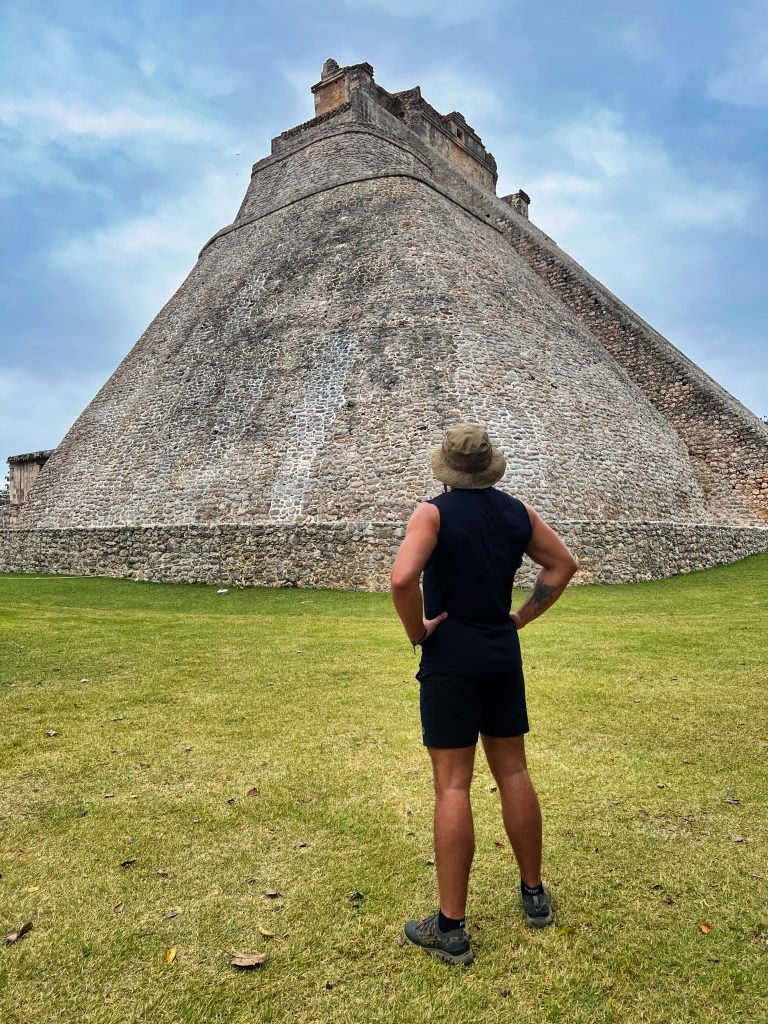
Rising dramatically from the ancient city of Uxmal, the Pyramid of the Magician isn’t just any Mayan monument. With its unique oval base, steep incline, and legends that whisper of a dwarf king’s magic, this architectural marvel stands as a testament to the ingenuity and mystique of a civilization long gone. Dive into its captivating tales and architectural wonders, as we journey back in time to one of the Mayan world’s most enchanting edifices.
General Information
- Height: Stands approximately 35 meters (115 feet) tall.
- Climbing and Interior Access: As of January 2022, climbing and interior access are restricted.
- Visit Timing: The dry season (November to April) is ideal. Typically less crowded than other major Mayan sites, especially in the early morning or late afternoon.
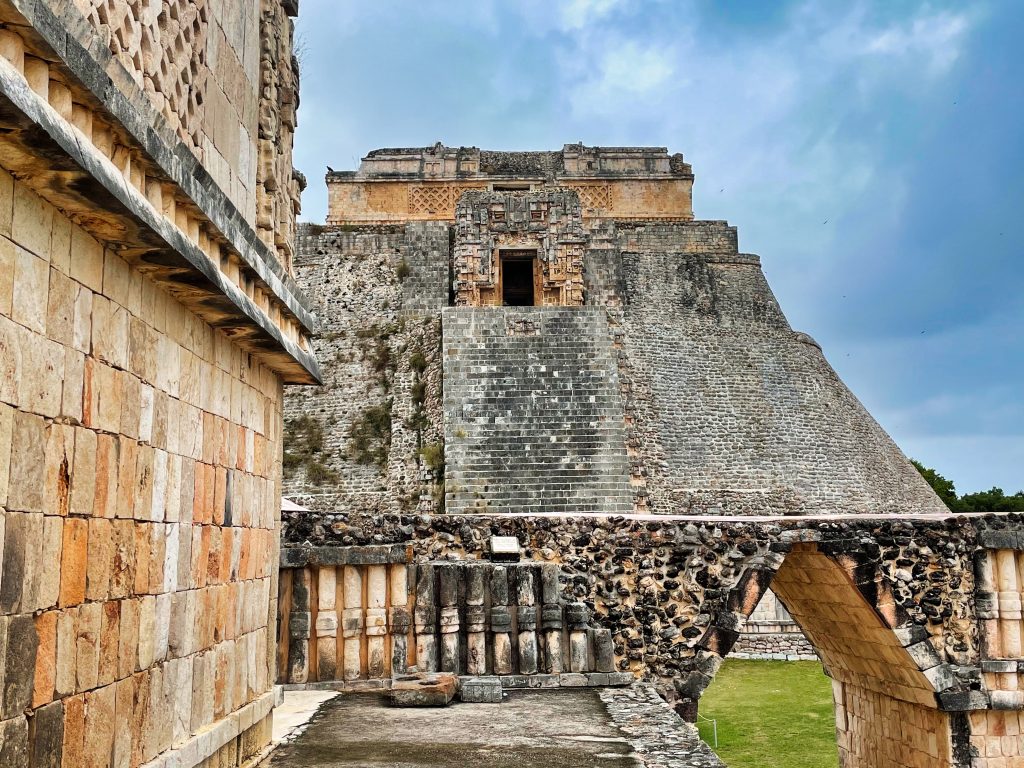
Truthfully, the Pyramid of the Magician tops my list of favorites. One key reason is the serenity due to the lack of crowds, allowing you to truly connect with its historical aura and potency. Moreover, its impressive preservation makes exploring it a fascinating experience. Just standing at the entrance, one can almost visualize a scene straight out of ‘Apocalypto’, with a shaman emerging, echoing rituals of ancient sacrifices. It’s a breathtaking site, and I highly recommend a visit.
3. Zona Arqueológica de Kabah
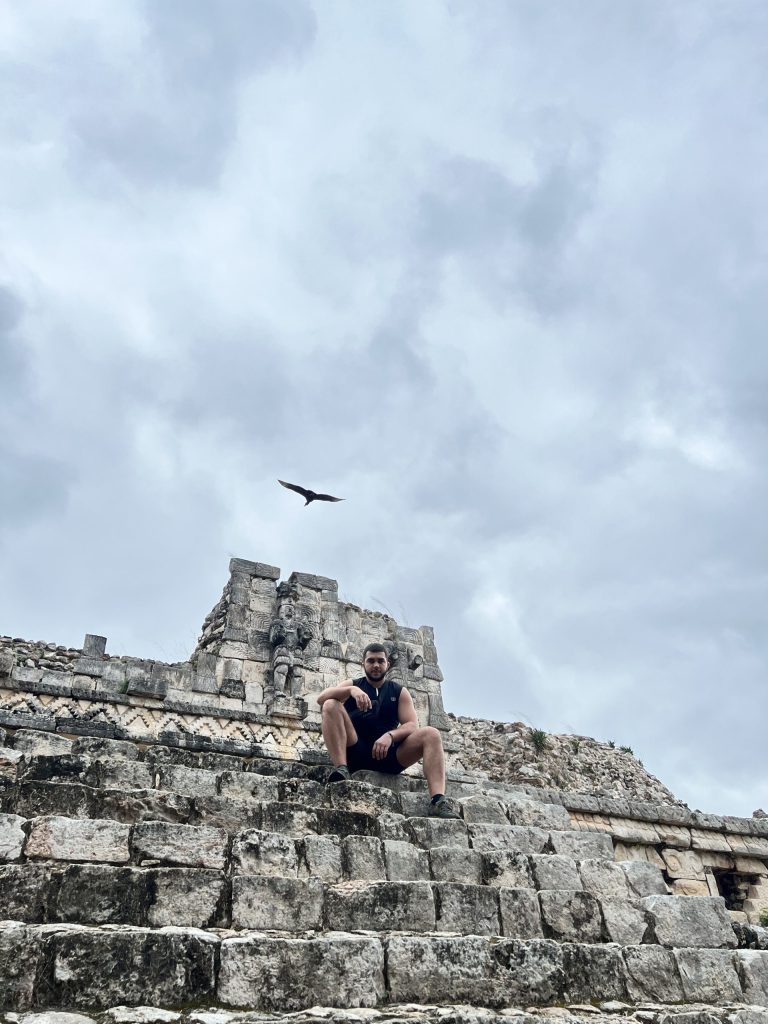
Kabah, located in Mexico’s Yucatán state, stands as a vital archaeological testament to the Mayan Puuc region, second only to Uxmal in size. Connected to Uxmal by a ceremonial causeway, Kabah flourished around the 9th century AD. Its architectural crown jewel, the «Palace of the Masks» or «Codz Poop,» is renowned for its intricate stone mosaics and the repeated masks of the rain god, Chaac. While many of its structures remain in a state of ruin, ongoing restoration efforts aim to preserve Kabah’s historic and artistic significance
General Information
- Heights: While specific heights of all structures vary, the Codz Poop (Palace of the Masks) is among the most prominent, though not as tall as many pyramids at other Mayan sites.
- Climbing and Interior Access: Some structures allow climbing, while others don’t due to preservation efforts. Interior access is generally limited.
- Visit Timing: The dry season, from November to April, is recommended. Kabah is typically less crowded than more famous sites like Uxmal or Chichen Itza, especially during weekday mornings.
4. Edzná — Campeche
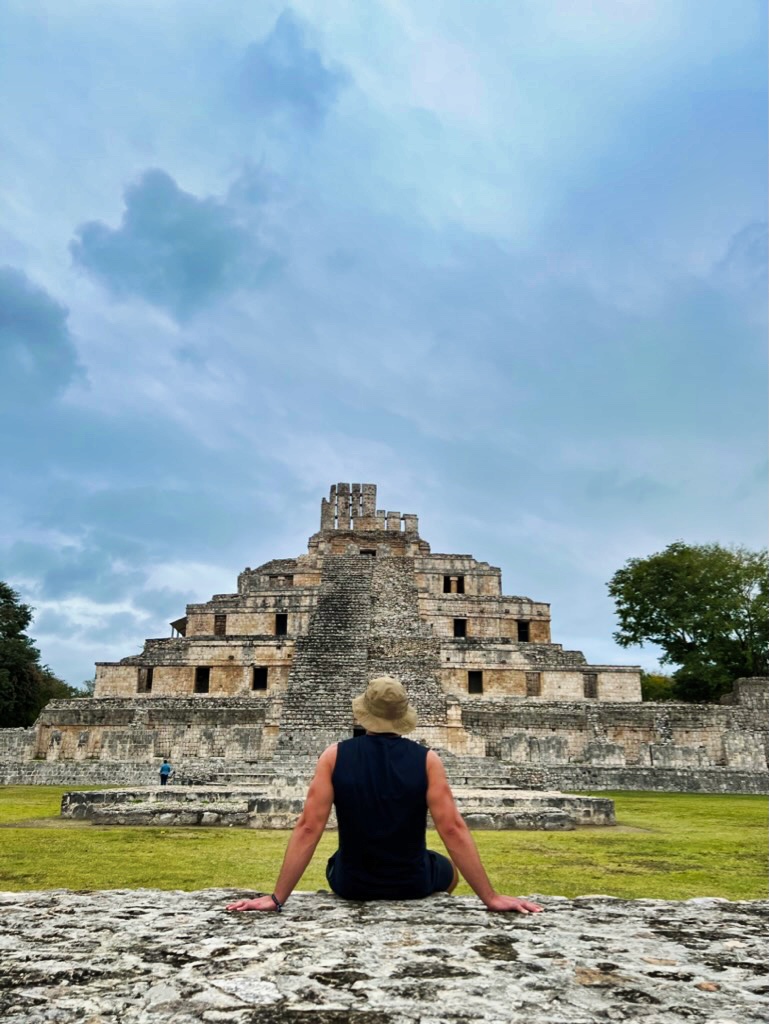
Lost amidst the lush greenery of Campeche lies Edzná, a hidden gem of Mayan majesty. With its history echoing in every stone and its grandeur standing defiantly against time, Edzná invites explorers to step into a world where ancient tales come to life.
Edzná’s foundations are steeped in the rich tapestry of Mayan civilization. Originally established as an agricultural community around 600 BC, the city flourished as a ceremonial and trade center due to its strategic location. The intricate canal systems suggest that the Mayans at Edzná had a deep understanding of hydrology, using it to their advantage for agriculture and to manage water resources, especially during the dry seasons.
Interesting Facts:
- Architectural Confluence: Edzná features a unique blend of architectural styles, including Petén, Chenes, and Puuc. This suggests that the city had varied influences and interactions with neighboring regions.
- Five-Story Building: The «Edificio de los Cinco Pisos» (Five-Story Building) is one of the most impressive structures in Edzná. Unlike many Mayan pyramids which are steep and tall, this building is broad and has multiple rooms, suggesting it might have been a communal or administrative center.
- The Great Acropolis: This massive structure houses several important buildings and offers an elevated view of the entire site, indicating its significance in ceremonies and as a focal point of the city.
- Advanced Water Management: Edzná is renowned for its sophisticated network of canals, cisterns, and reservoirs. This water management system is a testament to the city’s adaptability and advanced engineering.
In essence, Edzná wasn’t merely a religious center. It was a hub of innovation, trade, and cultural amalgamation, reflecting the ever-evolving dynamism of the Mayan civilization.
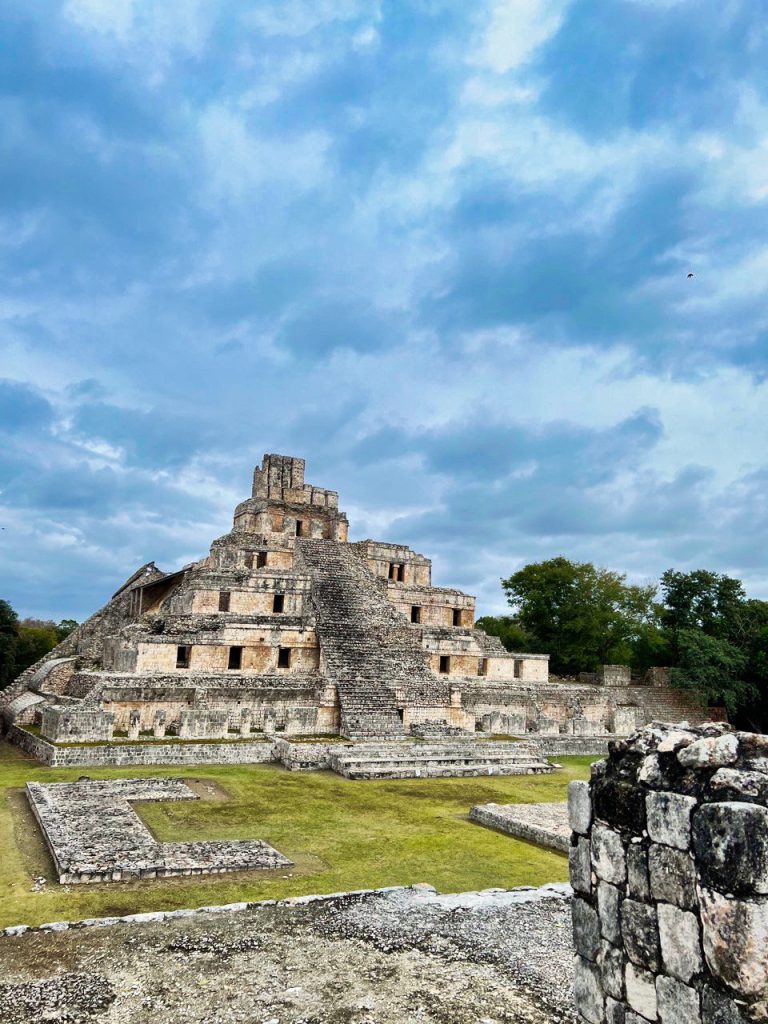
5. Coba – Quintana Roo: Ancient Mayan Legacy Amidst the Jungle
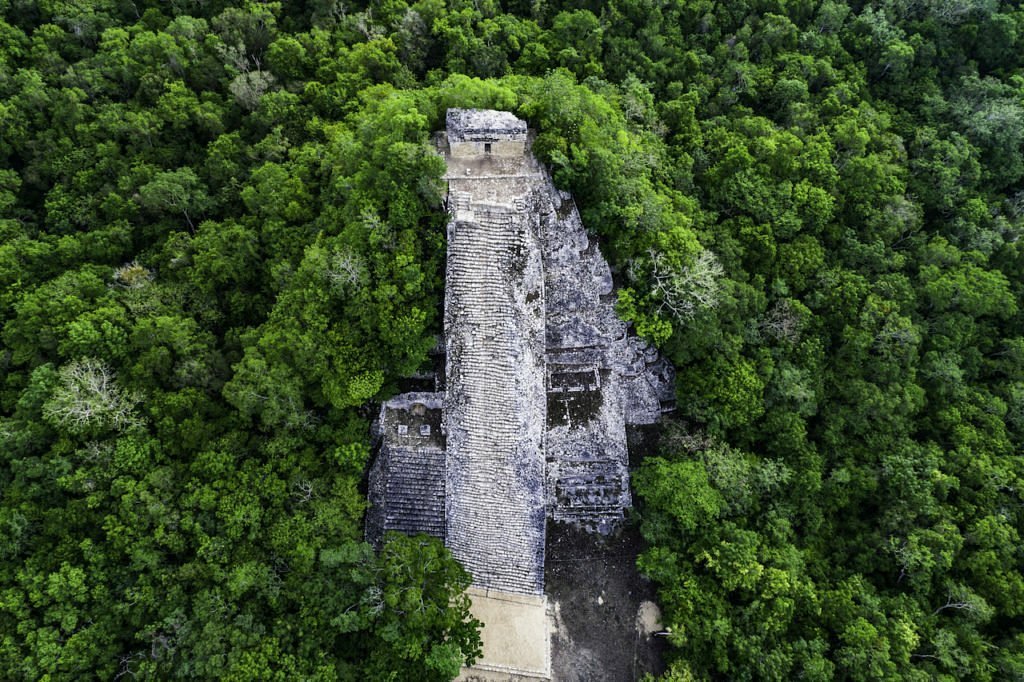
Situated in the state of Quintana Roo, Coba lies nestled amidst dense rainforest, giving it an aura of a forgotten city being reclaimed by nature. Its seclusion and sprawling layout contrast with the more well-known and compact sites like Chichen Itza or Tulum.
Coba was a powerful city-state that flourished between the 7th and 10th centuries AD. It was a crucial hub of trade and exerted significant influence over the northeastern Yucatan Peninsula. Its extensive network of sacbes (stone-paved roads) connected it to other cities and regions, showcasing its importance and extensive reach.Nohoch Mul Pyramid: This is the tallest pyramid in the Yucatan Peninsula, standing at a staggering 42 meters (138 feet) in height. Visitors who brave the climb are rewarded with panoramic views of the surrounding jungle.
- Sacbes: Coba boasts an extensive system of sacbes, with the longest one stretching for over 100 kilometers, linking Coba to Yaxuna near Chichen Itza.
- Ball Courts: Like many Mayan cities, Coba features ball courts used for playing the Mesoamerican ballgame, a sport with deep religious and cultural significance.
- Modern Exploration: Despite its historical significance, Coba remains relatively less frequented than other Mayan sites, offering a more peaceful and immersive exploration experience. Much of Coba is still enveloped by the jungle, and many of its structures remain unexcavated, adding to its mysterious allure.
Coba, with its towering pyramids, sprawling landscape, and vast road network, stands as a testament to its once grand status in the Mayan world. The mix of its historical importance, enveloping jungle, and fewer crowds makes it a must-visit for those seeking a deeper dive into Mayan history and culture.
The End
As we draw this journey through the best ruins in Yucatan to a close, I extend my heartfelt gratitude for joining me on this voyage into the past. The Mayan pyramids of Yucatan aren’t just remnants of stone; they’re silent storytellers of a bygone era. From their majestic heights to their intricate carvings, they echo tales of civilizations, rituals, and cosmic mysteries.
Mexico, with its rich tapestry of history and culture, truly is a hidden gem, teeming with experiences that cater to every member of the family. From the depths of its jungles to the peaks of its pyramids, it beckons with promises of discovery and wonder.
Thank you for reading, and may your own journeys, whether in Yucatan or beyond, be filled with curiosity and awe.
NomadicGeorge
I'm a 26-year-old digital marketer with a passion for exploring the globe. Having journeyed through 20 countries, my love for sports, history, adventure, and hiking has only grown. Traveling isn't just a hobby for me; it's a way of life. Join me as I share my experiences from around the world.
